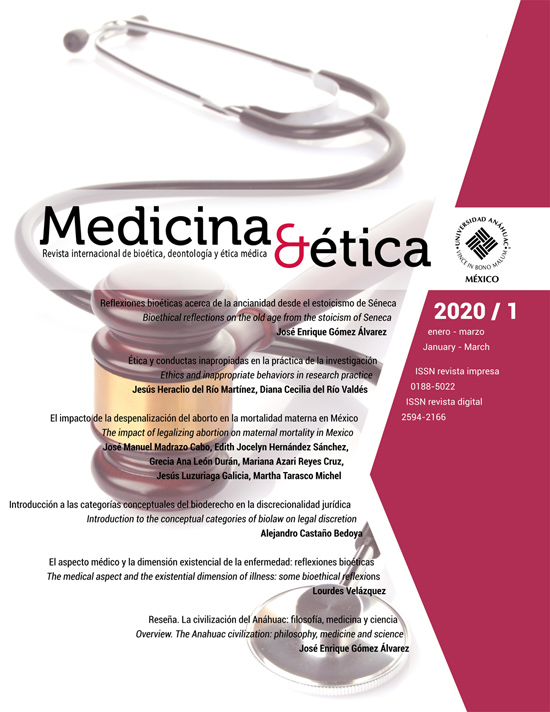Introduction to the conceptual categories of biolaw on legal discretion
Main Article Content
Abstract
The identification of the epistemological dispersion regarding decisions made in biolaw becomes evident in the critical incorporation of materialism and new forms of physicalism, since its epistemological
basis refers to a broader context than the unifying relationship between mind and brain. Hence, the argumentative theories adopted by authors such as Wroblesky, Aarnio and Alexy, who identify a double requirement to justify, namely: 1) the internal justification, regulated by logic when connecting premises or staments that are part of the judicial reasoning; 2) the external justification that emphasizes in the arguments or reasons to justify those premises or staments.
Biolaw implies recognizing that psychopathology has already traveled the road to understand phenomena such as intentionality, interpretation and interpretative assumptions of the architecture of legal decision. Those who study biolaw must identify those assumptions that sometimes are thoughtless. This implies giving reasons about the underlying mind-body relationship, those elements that make up the legal the relevant human action, and the configuration of the basic human goods involved in the litis of the biolaw. All these elements that force us to rethink the cognitive status of the law in general, and the biolaws in particular.
Downloads
PLUMX Metrics
Article Details
Medicina y Ética is distributed under a Creative Commons License Atribución-NoComercial-CompartirIgual 4.0 Internacional.
The author keeps the property rights with no restriction whatsoever and guarantees the magazine the right to be the first publication of the work. The author is free to deposit the published version in any other medium, such as an institutional archive or on his own website.
References
https://doi.org/10.24850/j-tyca-2018-01-01
(2) RAMOS-KURI, M. Análisis crítico a la sentencia de la Corte Interamericana de Derechos Humanos en el fallo sobre fertilización in vitro. Querétaro, Centro de Investigación Social Avanzada A. C. 2016. Consultado el 28 de noviembre de 2017 en: http://cisav.mx/wp-ntent/uploads/2017/04/Costa-Rica-Artavia_Murillo_Vs_Costa_Rica-FINAL.pdf; https://doi.org/10.32719/26312484.2019.31.9
(3) Sentencia T-070/1.
(4) BELLOCH, A. Manual de Psicopatología. McGraw-Hill, Madrid, 1995.
(5) ZUBIRI, X. Naturaleza, Historia y Dios. Ed. Nacional, Madrid, 1979.
(6) POPPER, K. El yo y su cerebro. Labor, Barcelona, 1993.
(7) LLINÁS, R. El cerebro y el mito del yo. Norma, Bogotá, 2002.
(8) CHURCHLAND, P.S. LLINÁS, R. Introducción al continum mente-cerebro. Universidad del Rosario y U. Nacional, Bogotá, 2006.
(9) SUCAR, G. Concepciones del derecho y la verdad jurídica. Marcial Pons, Madrid, Barcelona, Buenos Aires, 2008.
(10) MASSINI, C.I. Filosofía del Derecho. Lexis-Nexis, Buenos Aires, 1994.
(11) SAHUÍ, A., MALDONADO, A. John Rawls del consenso entrecruzado al equilibrio reflexivo. Algunas consideraciones acerca del uso público de la razón. Signos filosóficos. 2005; 6: 211-240.
(12) CASTAÑO, A. Los referentes de la justicia: Razonabilidad y bien. Un debate entre el constructivismo de J. Rawls y el nuevo derecho natural. Civilizar. 2013; 50-73. https://doi.org/10.22518/16578953.113
(13) BROCANO, F. El control racional de la conducta. Trotta, Madrid, 1995.
(14) KAUFMANN, A. Filosofía del Derecho. Universidad Externado, Bogotá, 1999.
(15) GADAMER, G. Verdad y método. Sígueme, Madrid, 1986.

